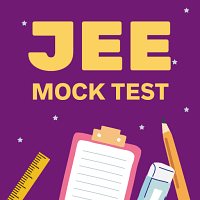JEE Exam > JEE Questions > A 3μF capacitor is charged to a potentialo...
Start Learning for Free
A 3 μF capacitor is charged to a potential of 300 V and a 2 μF capacitor is charged to a potential of 200 V. The capacitors are then connected in parallel with plates of opposite polarity joined together. What amount of charge will flow when the plates are so connected
- a)600 μC
- b)700 μC
- c)250 μC
- d)1300 μC
Correct answer is option 'A'. Can you explain this answer?
| FREE This question is part of | Download PDF Attempt this Test |
Most Upvoted Answer
A 3μF capacitor is charged to a potentialof 300 V and a 2μF capa...
The number 3 is a positive integer that comes after the number 2 and before the number 4. It is an odd number, meaning it is not divisible evenly by 2. In terms of multiplication, 3 times 1 equals 3, 3 times 2 equals 6, 3 times 3 equals 9, and so on. It is also a prime number, as it is only divisible evenly by 1 and itself.
Free Test
FREE
| Start Free Test |
Community Answer
A 3μF capacitor is charged to a potentialof 300 V and a 2μF capa...
Before connections,
C1 = 3µF, V1 = 300V
Charge on C1,
Q1 = 900μC
C2 = 2µF, V1 = 200V
Charge on C2,
Q2 = 400μC
When the positive terminal of C1 is connected with the negative terminal of C2, common potential of the system is:

Substituting the values, we get
V = 100V
New charge on posiitve plate of C1,
Q'1 = 3 x 100 = 300µC
So, charge Q1 - Q'1 = 600 µC has flown from the positive plate of the C1 to the negative plate of C2.
C1 = 3µF, V1 = 300V
Charge on C1,
Q1 = 900μC
C2 = 2µF, V1 = 200V
Charge on C2,
Q2 = 400μC
When the positive terminal of C1 is connected with the negative terminal of C2, common potential of the system is:

Substituting the values, we get
V = 100V
New charge on posiitve plate of C1,
Q'1 = 3 x 100 = 300µC
So, charge Q1 - Q'1 = 600 µC has flown from the positive plate of the C1 to the negative plate of C2.
Attention JEE Students!
To make sure you are not studying endlessly, EduRev has designed JEE study material, with Structured Courses, Videos, & Test Series. Plus get personalized analysis, doubt solving and improvement plans to achieve a great score in JEE.

|
Explore Courses for JEE exam
|

|
A 3μF capacitor is charged to a potentialof 300 V and a 2μF capacitor is chargedto a potential of 200 V. The capacitors are then connected in parallel with plates of opposite polarity joined together. What amount of charge will flow when the plates are so connecteda)600 μCb)700 μCc)250 μCd)1300 μCCorrect answer is option 'A'. Can you explain this answer?
Question Description
A 3μF capacitor is charged to a potentialof 300 V and a 2μF capacitor is chargedto a potential of 200 V. The capacitors are then connected in parallel with plates of opposite polarity joined together. What amount of charge will flow when the plates are so connecteda)600 μCb)700 μCc)250 μCd)1300 μCCorrect answer is option 'A'. Can you explain this answer? for JEE 2024 is part of JEE preparation. The Question and answers have been prepared according to the JEE exam syllabus. Information about A 3μF capacitor is charged to a potentialof 300 V and a 2μF capacitor is chargedto a potential of 200 V. The capacitors are then connected in parallel with plates of opposite polarity joined together. What amount of charge will flow when the plates are so connecteda)600 μCb)700 μCc)250 μCd)1300 μCCorrect answer is option 'A'. Can you explain this answer? covers all topics & solutions for JEE 2024 Exam. Find important definitions, questions, meanings, examples, exercises and tests below for A 3μF capacitor is charged to a potentialof 300 V and a 2μF capacitor is chargedto a potential of 200 V. The capacitors are then connected in parallel with plates of opposite polarity joined together. What amount of charge will flow when the plates are so connecteda)600 μCb)700 μCc)250 μCd)1300 μCCorrect answer is option 'A'. Can you explain this answer?.
A 3μF capacitor is charged to a potentialof 300 V and a 2μF capacitor is chargedto a potential of 200 V. The capacitors are then connected in parallel with plates of opposite polarity joined together. What amount of charge will flow when the plates are so connecteda)600 μCb)700 μCc)250 μCd)1300 μCCorrect answer is option 'A'. Can you explain this answer? for JEE 2024 is part of JEE preparation. The Question and answers have been prepared according to the JEE exam syllabus. Information about A 3μF capacitor is charged to a potentialof 300 V and a 2μF capacitor is chargedto a potential of 200 V. The capacitors are then connected in parallel with plates of opposite polarity joined together. What amount of charge will flow when the plates are so connecteda)600 μCb)700 μCc)250 μCd)1300 μCCorrect answer is option 'A'. Can you explain this answer? covers all topics & solutions for JEE 2024 Exam. Find important definitions, questions, meanings, examples, exercises and tests below for A 3μF capacitor is charged to a potentialof 300 V and a 2μF capacitor is chargedto a potential of 200 V. The capacitors are then connected in parallel with plates of opposite polarity joined together. What amount of charge will flow when the plates are so connecteda)600 μCb)700 μCc)250 μCd)1300 μCCorrect answer is option 'A'. Can you explain this answer?.
Solutions for A 3μF capacitor is charged to a potentialof 300 V and a 2μF capacitor is chargedto a potential of 200 V. The capacitors are then connected in parallel with plates of opposite polarity joined together. What amount of charge will flow when the plates are so connecteda)600 μCb)700 μCc)250 μCd)1300 μCCorrect answer is option 'A'. Can you explain this answer? in English & in Hindi are available as part of our courses for JEE.
Download more important topics, notes, lectures and mock test series for JEE Exam by signing up for free.
Here you can find the meaning of A 3μF capacitor is charged to a potentialof 300 V and a 2μF capacitor is chargedto a potential of 200 V. The capacitors are then connected in parallel with plates of opposite polarity joined together. What amount of charge will flow when the plates are so connecteda)600 μCb)700 μCc)250 μCd)1300 μCCorrect answer is option 'A'. Can you explain this answer? defined & explained in the simplest way possible. Besides giving the explanation of
A 3μF capacitor is charged to a potentialof 300 V and a 2μF capacitor is chargedto a potential of 200 V. The capacitors are then connected in parallel with plates of opposite polarity joined together. What amount of charge will flow when the plates are so connecteda)600 μCb)700 μCc)250 μCd)1300 μCCorrect answer is option 'A'. Can you explain this answer?, a detailed solution for A 3μF capacitor is charged to a potentialof 300 V and a 2μF capacitor is chargedto a potential of 200 V. The capacitors are then connected in parallel with plates of opposite polarity joined together. What amount of charge will flow when the plates are so connecteda)600 μCb)700 μCc)250 μCd)1300 μCCorrect answer is option 'A'. Can you explain this answer? has been provided alongside types of A 3μF capacitor is charged to a potentialof 300 V and a 2μF capacitor is chargedto a potential of 200 V. The capacitors are then connected in parallel with plates of opposite polarity joined together. What amount of charge will flow when the plates are so connecteda)600 μCb)700 μCc)250 μCd)1300 μCCorrect answer is option 'A'. Can you explain this answer? theory, EduRev gives you an
ample number of questions to practice A 3μF capacitor is charged to a potentialof 300 V and a 2μF capacitor is chargedto a potential of 200 V. The capacitors are then connected in parallel with plates of opposite polarity joined together. What amount of charge will flow when the plates are so connecteda)600 μCb)700 μCc)250 μCd)1300 μCCorrect answer is option 'A'. Can you explain this answer? tests, examples and also practice JEE tests.

|
Explore Courses for JEE exam
|

|
Suggested Free Tests
Signup for Free!
Signup to see your scores go up within 7 days! Learn & Practice with 1000+ FREE Notes, Videos & Tests.






















